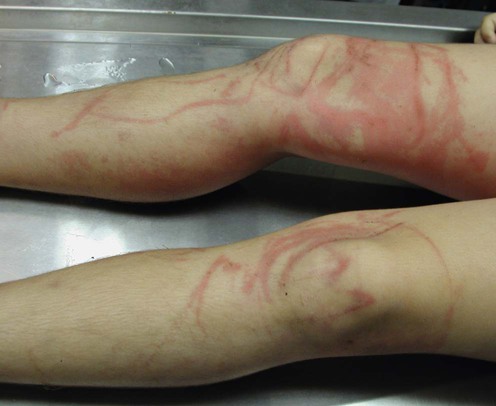| Prevention of jellyfish stings |
 Stinger suits worn next to the skin reduce contact with jellyfish tentacles Stinger suits worn next to the skin reduce contact with jellyfish tentacles |
E |
 Stinger nets to provide physical barrier between jellyfish and swimmers (NB: these are only effective on jellyfish which are larger than the net mesh size) Stinger nets to provide physical barrier between jellyfish and swimmers (NB: these are only effective on jellyfish which are larger than the net mesh size) |
E |
 Proprietary Safe Sea cream (NB: this treatment may cause the discharge of more nematocysts in some species) Proprietary Safe Sea cream (NB: this treatment may cause the discharge of more nematocysts in some species) |
A |
 Removing bathing suits and showering to reduce/prevent seabather’s eruption Removing bathing suits and showering to reduce/prevent seabather’s eruption |
E |
| Immediate management of stings |
 Sting victims should be removed from the water Sting victims should be removed from the water |
E |
 Those providing care to sting victims must avoid being stung by the jellyfish Those providing care to sting victims must avoid being stung by the jellyfish |
E |
 Immediately remove any tentacles (the dermis on fingers is usually thick enough to prevent significant envenoming to the first aider) Immediately remove any tentacles (the dermis on fingers is usually thick enough to prevent significant envenoming to the first aider) |
E |
 Wash sting site with sea water (not fresh water) Wash sting site with sea water (not fresh water) |
E |
 Identify type of jellyfish involved Identify type of jellyfish involved |
E |
 Cardiopulmonary resuscitation if needed (usually only necessary for box jellyfish) Cardiopulmonary resuscitation if needed (usually only necessary for box jellyfish) |
E |
| Topical agents to provide analgesia |
 Lignocaine Lignocaine |
C |
 Ice Ice |
C |
 Hot water Hot water |
A |
| Major box jellyfish (Chironex fleckeri) stings |
 Apply liberal amounts of vinegar to sting site to inactivate any undischarged nematocysts Apply liberal amounts of vinegar to sting site to inactivate any undischarged nematocysts |
C |
 Cardiac monitoring, supportive care, and cardiopulmonary resuscitation if required Cardiac monitoring, supportive care, and cardiopulmonary resuscitation if required |
D |
| All but very minor box jellyfish stings require transport to hospital for: |
 Oral and parenteral analgesia Oral and parenteral analgesia |
C |
 Administration of intravenous antivenom Administration of intravenous antivenom |
D |
 Administration of intravenous magnesium Administration of intravenous magnesium |
D |
| Irukandji jellyfish stings |
 Apply liberal amounts of vinegar to sting Apply liberal amounts of vinegar to sting |
C |
| The majority of stings require hospital admission for: |
 Oral and parenteral analgesia Oral and parenteral analgesia |
C |
 Cardiac monitoring, supportive care, and cardiopulmonary resuscitation if required Cardiac monitoring, supportive care, and cardiopulmonary resuscitation if required |
D |
| Bluebottle and Portuguese man-of-war stings |
 Application of hot water (45°C) gives rapid and significant relief Application of hot water (45°C) gives rapid and significant relief |
C |


